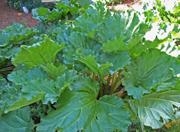Client's Situation and Question: My rhubarb tends to die back in the summer much earlier than I think it should or expect. I know that the soils where it is planted are marginal and I haven't fertilized the rhubarb. I do give it regular water. What is causing the early summer die back? and how can I improve the health, vigor, and survival of my rhubarb? 
all pix SCMG
UC MGCC Program's Help Desk Response: We believe that the rhubarb's early die back may be due to a combination of lack of fertility and Contra Costa County's hot summer temperatures. Rhubarb plants do best if fertilized regularly. If you want to grow organically, you can use a six-inch layer of good compost around the base of the plant. The compost will provide a continuous nutrient source that may last for several months. Rhubarb also responds well to manure, but be sure that it has been well composted since applying fresh manure will burn the plant. You can purchase composted manure at a nursery or home supply store. It can be mixed into the compost before you put it around the plant.
Another contributing cause of the summer die back could be hot summer temperatures. Die back is a common response to temperatures that are too high. Although rhubarb likes plenty of sun, providing some shade on hot summer afternoons may help.
Hope this info helps your rhubarb thrive. It's a great perennial vegetable to have in your garden—does well in desserts but can also be used in savory dishes.
UC Master Gardener Program of Contra Costa's Help Desk (TKL)
Editor: Although this response is written for Contra Costa County gardeners, thanks go to the UC Master Gardeners of Sonoma County for input.
Don't miss our 2016 Great Tomato Plant Sale:
@ http://ccmg.ucanr.edu/EdibleGardening/GreatTomatoPlantSale/
Note: The UC Master Gardeners Program of Contra Costa's Help Desk is available year-round to answer your gardening questions. Except for a few holidays, we're open every week, Monday through Thursday for walk-ins from 9:00 am to Noon at 75 Santa Barbara Road, 2d Floor, Pleasant Hill, CA 94523. We can also be reached via telephone: (925) 646-6586, email: ccmg@ucanr.edu, or on the web at http://ccmg.ucanr.edu/Ask_Us/ MGCC Blogs can be found at http://ccmg.ucanr.edu/HortCoCo/ You can also subscribe to the Blog at //ucanr.edu/blogs/CCMGBlog/.